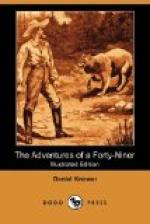After a few operations of that kind you would see the yellow scales of gold on the edge of the sand. You would continue that process until there was but a little of the sand left; then you would take it with you when you went to the tank and warm it by a fire to dry the sand; then with your breath you would blow away the sand and have the gold, which you carried in a buckskin bag, which was the currency of the country, at $16 per ounce, and at the mint in Philadelphia was worth $18.25. I have carried three hundred buckets in a day, and at twenty-five cents worth of gold in a bucket, it would amount to $75, $25 to each man for his day’s work, which was frequently the average. In those days all it cost for a party of three for capital to start mining was about $15. Then you had the chances of striking a pocket. That was a cavity in the rocks where gold had settled. In the course of ages, and where the strong currents of the streams, when the rivers were high, could not reach it to wash it out, I have known a person to take out $800 of gold in less than an hour. The first miners, when they found gold on the banks of the river, thought if they could only dig in the deep holes of the bed they would find chunks of it, and they went to a big expense, and those who had money hired laborers to assist in constructing raceways at $16 per day, to change the current of the river; but when they had effected their object and dug there they found no gold, for there was nothing to prevent the strong current from carrying it off; but I knew a party to draw off the water and expose the bed of the river, where there were rapids, and they were successful, and the gold had settled down between the crevices of the rocks, and the currents could not disturb it.
There were some other kinds of diggings discovered different from the river mining, called canons, one I know of, called the Oregon. It was described like a tunnel, deep down in the earth, where a party of three persons from near our locality went and returned in about three weeks and had from three to five thousand dollars apiece, which they showed me. It was not scale gold, but nuggets of all sizes. Of course, they had unusual luck.
On the river mining each person was entitled to so many feet, as long as they left any implements of labor on it. No person would trespass upon it; but if he took every thing away, then it was inferred he had given it up, and anybody had a right to take it. All regulations were strictly respected and every thing was safe, and a person told me that he would not be afraid to leave his bag of gold in his tent. Every thing was honorable and safe until the overland emigrants from western Missouri arrived there.
They were a different kind of people; more of the brute order. When they saw a party of two or three that had a good claim, and they were the strongest, they would dispossess them. (I suppose the same class that raided Kansas in John Brown’s time.) They became so obnoxious that a respectable man would deny his State.




